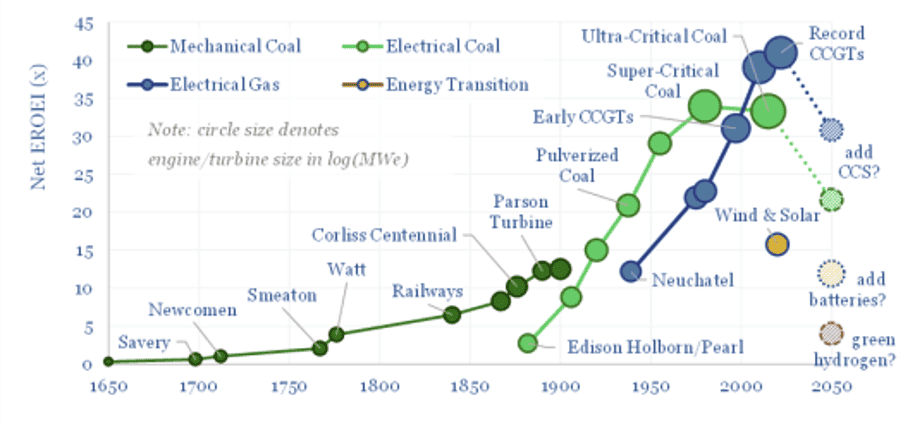Der EROEI entscheidet über die Energiewende
Ich habe es in meinem Podcast kurz erwähnt: das Konzept des Net energy return on energy invested (EROEI) – also der Frage, wieviel Energie man aufwenden muss, um wieviel Energie auszubeuten. In meiner Vorbereitung bin ich auf diesen Beitrag gestoßen:
„Net energy return on energy invested (EROEI) is the best metric for comparing end-to-end energy efficiencies. Wind and solar currently have EROEIs that are lower and ‘slower’ than today’s global energy mix; stoking upside to energy demand and capex. But future wind and solar EROEIs could improve 2-6x. This will be a make-or-break factor determining the ultimate share of renewables?“ – bto: Das wäre nicht nur erfreulich, sondern wohl auch notwendig für eine erfolgreiche Energiewende.

Quelle: Thunder Said Energy
„Energy efficiency matters because it determines how much primary energy needs to be supplied, in order to meet the ultimate energy demands of human civilization. If energy efficiency surprises to the upside, then the demand for coal, oil and gas will surprise to the downside. Or vice versa. We are worried that over-optimistic assumptions about future energy efficiency gains will culminate in energy shortages.“ – bto: Ich finde, wir können das in Deutschland gut beobachten. In der Diskussion wird gerne auf die Erzeugungskapazität geachtet, ohne zu erwähnen, dass die Erneuerbaren Energien nicht immer produzieren. Ebenfalls ausgeblendet werden die Doppelstrukturen.
„Net energy return on energy invested is the best way to compare total life cycle efficiencies of different energy sources, apples-to-apples. For example, it takes 100kWh of energy inputs to mine 1 ton of coal, which contains 6,500 kWh of thermal energy (65x gross EROEI), and then yields 4,000 kWh of useful heat and power (40x net EROEI).“ – bto: Deshalb sind die fossilen Energien auch so entscheidend für den Wohlstand.
„Our best estimates are that the net EROEI for wind today is around 23x and the net EROEI for solar today is around 12x. It has taken us about four years to build up these numbers, across dozens of different economic models. Of course, the numbers vary case by case, especially based on where these renewables are deployed.“ – bto: Das wird bei uns auch gerne geleugnet, es gibt aber nunmal in Bayern weniger Wind. In Summe gibt es auch weniger Sonne.
„Renewables have net energy returns on energy investment that are ‘lower and slower’ than today’s blended average global energy, especially coal and gas, which (…) does mean the scale-up of wind and solar produces some questionable reversals of 300-year mega-trends, global energy demand is likely to surprise to the upside and global energy capex must treble to $4trn per year.“ – bto: Wir bauen also ein ineffizienteres neues Energiesystem.
“Could solar ultimately surpass the net EROEI of coal and gas by over 2x? There is historical precedent for fundamentally new energy technologies to improve over time, looking back at the development of steam cycles, early electrical generators, gas turbines.“ – bto: Das ist die Frage. Oder die Welt geht auf Atomkraft. Ich denke, genau das werden wir.

Quelle: Thunder Said Energy
→ thundersaidenergy.com: “EROEI: energy return on energy invested?”, 23. März 2023







